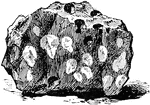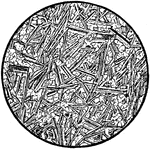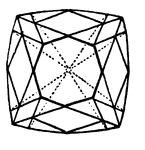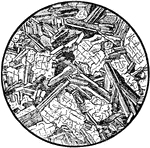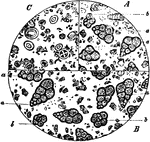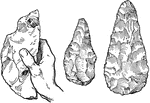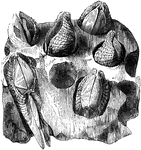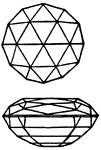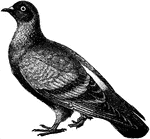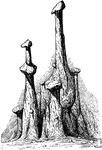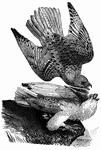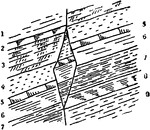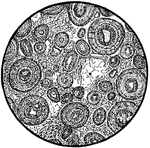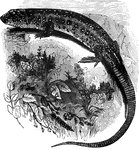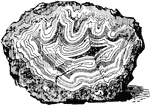
Agate
"A variety of quartz which is peculiar in consisting of bands or layers of various colors blended together."-Whitney,…
Breached Asymmetrical Anticline
Eroded fold, breached asymmetrical anticline, the hard stratum forming two opposing uniclines.

Cataract Creek
Cataract Creek rises on the slopes of Mount Bullengarook and drains across the lava flow towards the…
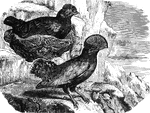
Cock-of-the-Rock
Approximately the size of pigeon, the cock of the rock has a distinctive crest of feathers arranged…
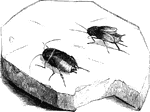
Common Cockroach
"Blattina includes the Cockroaches, the most noted species of which, the Black beetle or Common…
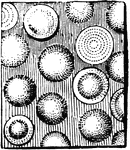
Concretionary Structure
This illustration shows a rock made up of rounded concretions, having a concentric structure.
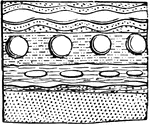
Concretionary Structure
This illustration shows a rock made up of all kinds of concretionary objects.
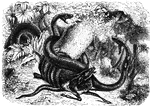
Boa constrictor
"The boa constrictor grows to great size, and greatly resembles the python in its habits." — Goodrich,…

Contorted Rocks
"Curved and contorted rocks, near Old Head of Kinsale." — Encyclopedia Britannica, 1893
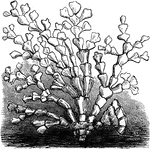
Coralline
Coralline Rock is a type of rock formed by the death of layers of Coralline algae. It is visually quite…
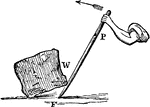
Crowbar and Stone
"... a farmer with a crowbar, as shown, can move a rock which with his hands alone he could not stir."…
Cut-off Basin
Diagrammatic cross-section of a cut off basin, and the deposits formed in it after complete evaporation.
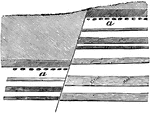
Displacement of Strata
"Section showing displacement of strata by a fault. a and a were once a continuous mass of rock." -Whitney,…
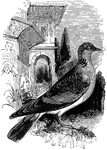
Rock dove
Common to Europe and Asia, the rock dove makes its home among the high rocks of the coast.

Dredge
Dredging, the excavating or scooping out of soil, mud, sand or rock under water by a machine called…
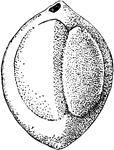
Eolianite
Eolianite or aeolianite is any rock formed by the lithification of sediment deposited by aeolian processes;…

Fault Line Valley
A fault line valley. A fault line, is a planar fracture in rock in which the rock on one side of the…
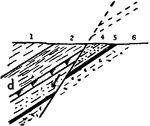
Gravity Fault
A fault is a planar fracture in rock in which the rock on one side of the fracture has moved with respect…

Gravity Fault
A fault is a planar fracture in rock in which the rock on one side of the fracture has moved with respect…

Gravity Fault
A fault is a planar fracture in rock in which the rock on one side of the fracture has moved with respect…

Gravity Fault
A fault is a planar fracture in rock in which the rock on one side of the fracture has moved with respect…

Gravity Fault
A fault is a planar fracture in rock in which the rock on one side of the fracture has moved with respect…

Thrust Fault
A thrust fault is a type of fault, or break in the Earth's crust with resulting movement of each side…

Thrust Fault
A thrust fault is a type of fault, or break in the Earth's crust with resulting movement of each side…

Thrust Fault
A thrust fault is a type of fault, or break in the Earth's crust with resulting movement of each side…
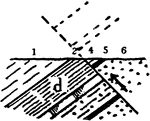
Thrust Fault
A thrust fault is a type of fault, or break in the Earth's crust with resulting movement of each side…
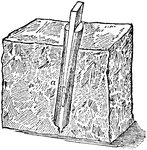
Feather and Tare
"Two pieces of metal placed in a hole in a stone which is to be split a wedge-shaped key or plug being…

Frue Vanner (Side View)
A Frue Vanner is a shaking, rubber belt used to concentrate gold ore 'pulp'.

Geyserite
"GEYSERITE. The variety of opaline silica deposited about the orifices of geysers. It occurs white or…
Gravel Hill
"Suppose a to be a gravel hill, and b a strata of clay or rock, impervious to water. The fluid percolating…

Hand and sucker
"The 'sucker' consists of a circular piece of thick leather with a string attached to its middle. Being…

Hornblende
Hornblende is a complex inosilicate series of minerals. Hornblende is not a recognized mineral in its…

Inclined Strata
Diagram to illustrate the underground extension of inclined strata which crop out on the surface, and…

Inclined Strata Dip and Strike
Diagram illustrating the relationships of dip and strike of the inclined strata of an outcropping series…

Jointed Rock
This illustration shows a jointed structure. In this drawing, there are two systems of joints or divisional…
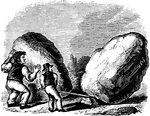
Knowledge is Power
"The engraving shows a large, powerful man, of giant size and strength, endeavoring to move a large…
Photographer Shooting Lion in Robe
An illustration of a photographer shooting a lion dressed in a robe leaning against a rock.
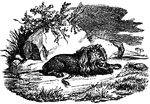
Recumbent Lion
Recumbent lion in front of a large rock is used as a tailpiece at the end of Mark's gospel in an old…
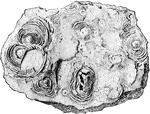
Lithophysa
A lithophysa (plural lithophysae) is a small cavity found in felsic volcanic rocks believed to be caused…

Man and child
An illustration with a man and a child watching birds fly overhead while standing on a rock.

